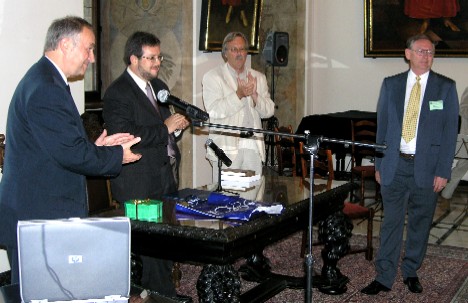![[ICPRBI]](images/LOGO_ICPRBI_web.jpg)
![[ICPRBI]](images/LOGO_ICPRBI_web.jpg)
| HERMAN P. SCHWAN AWARD |
| This new award was established by the
ICPRBI and presented at the Oslo Conference (XI ICEBI) for the first time.
It is to be given to a scientist having contributed to the field of
bioimpedance in a particular meritorious way. Anyone may forward
candidates to the current chairman of the ICPRBI |
|
| AWARDEES |
The 1st. H.P. Schwan Award was presented to Prof. Ronald Pethig during the XI ICEBI, in 2001, in Oslo for "his remarkable achievements over a broad spectrum of award-relevant activities, both in theory, applications and industrial innovations. His outstanding studies of the dielectric properties of single living cells in suspension, and the possible mechanical manipulation of such cells in an electric field. His important technological exploitation of this concept using miniaturised analytical measuring devices. His now classical book from 1979 "Dielectric and Electronic Properties of Biological Materials" with a fresh and original approach to the still unsolved problems of electronic and semiconductor properties of biological materials."
The 2nd. H.P. Schwan Award was presented to Prof. Brian H Brown, during the XII ICEBI, in 2004, in Gdansk, for "his achievements over a broad spectrum of bioimpedance award-relevant activities, from theoretical developments and instrumentation design to clinical applications and industrial innovations. By promoting bioimpedance tomography he has worked with many types of human living tissue, in particular lung and cervical tissue. He has made Sheffield a centre of bioimpedance research world wide known. He played an important role in the European Electrical Impedance Tomography project, without loosing sight of the whole field of bioimpedance. Emphasis has also been put on his pioneer work in impedance imaging, important technological exploitation of bioimpedance tomography and the development of the commercialised Sheffield EIT Systems"  |
Prof. Gersing died on May 22 2009. OBITUARY |
|
The 5th H. P. Schwan Award was given to Professor David Holder for his pioneering work in imaging brain activity with electrical impedance tomography. From the engineering point of view, this is extremely difficult, as not only the sources are very weak but the corresponding signals are also damped and corrupted by various mechanisms on their way to the surface. Many difficult problems were solved and finally he was successful in demonstrating the feasibility of imaging brain activation patterns in the cortex of an anesthetized rat by EIT. Throughout many years he has promoted EIT, an important sector of bioimpedance research, not only by his important scientific contributions but also by organizing and co-organizing a series of meetings and workshops. Within the impedance community he is one of the leading persons who try to push forward clinical applications of EIT. |